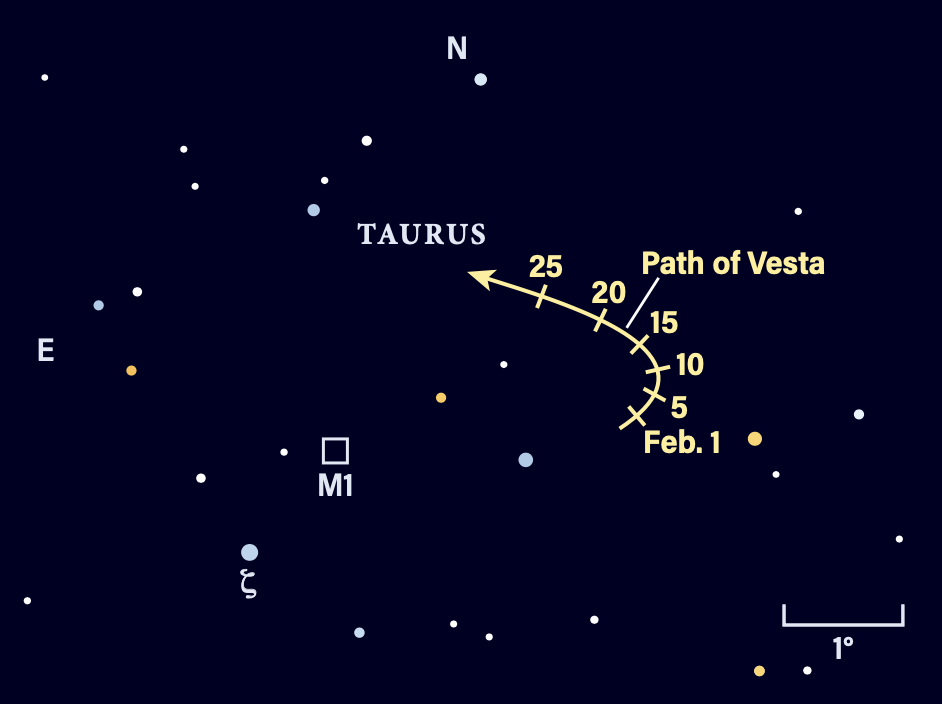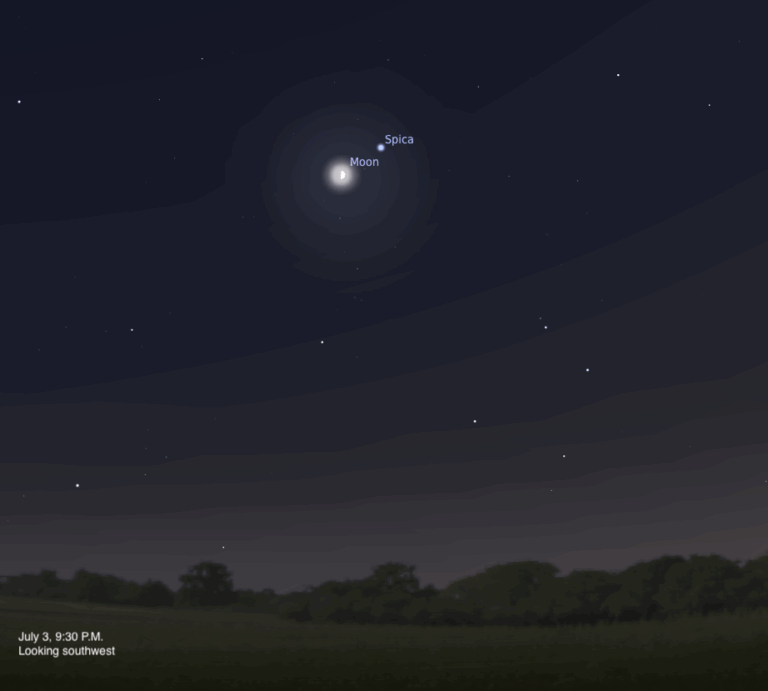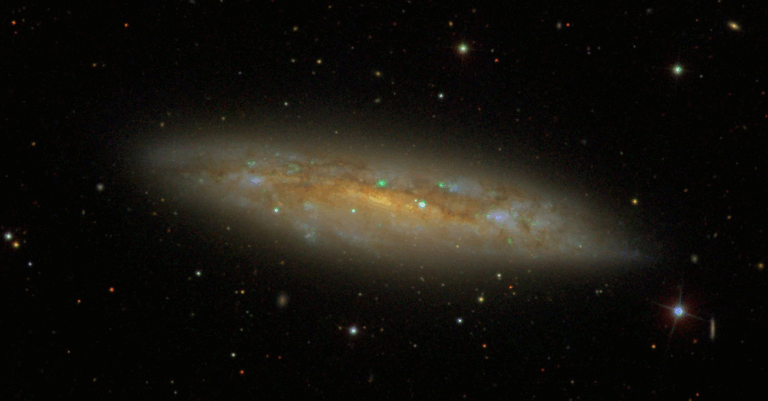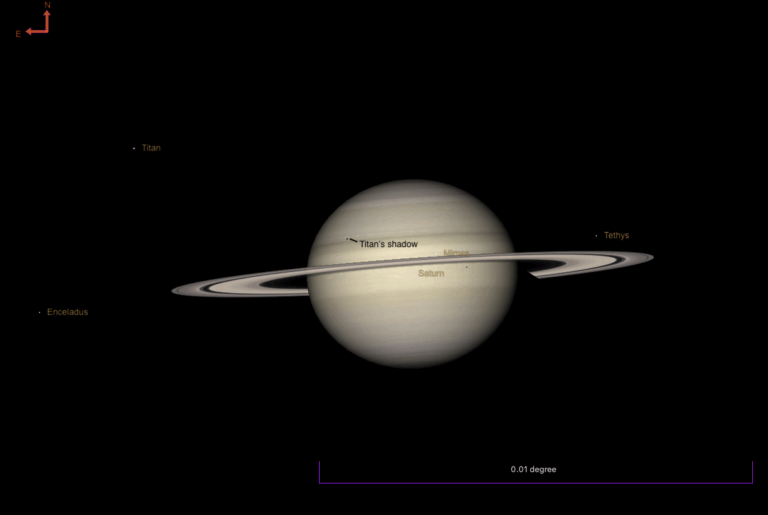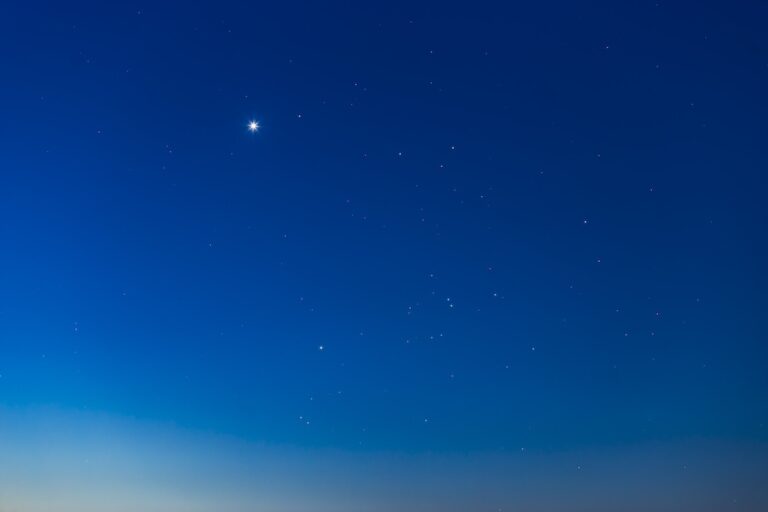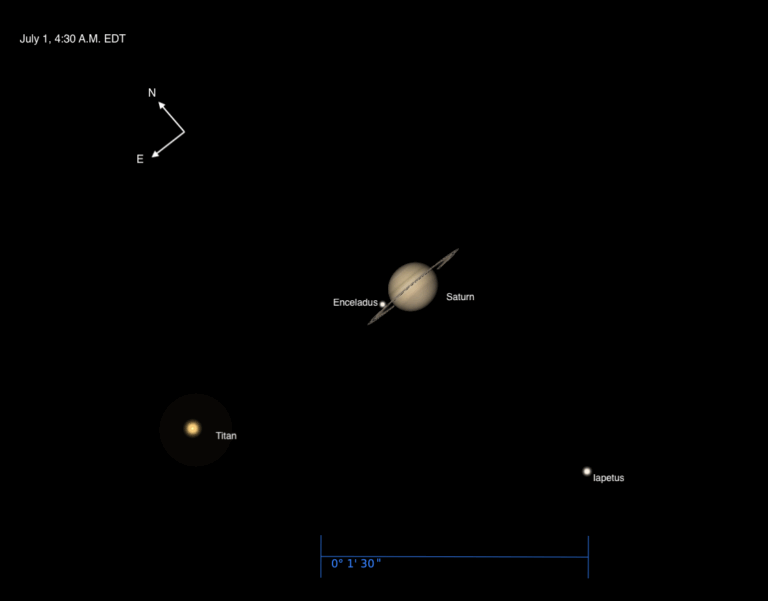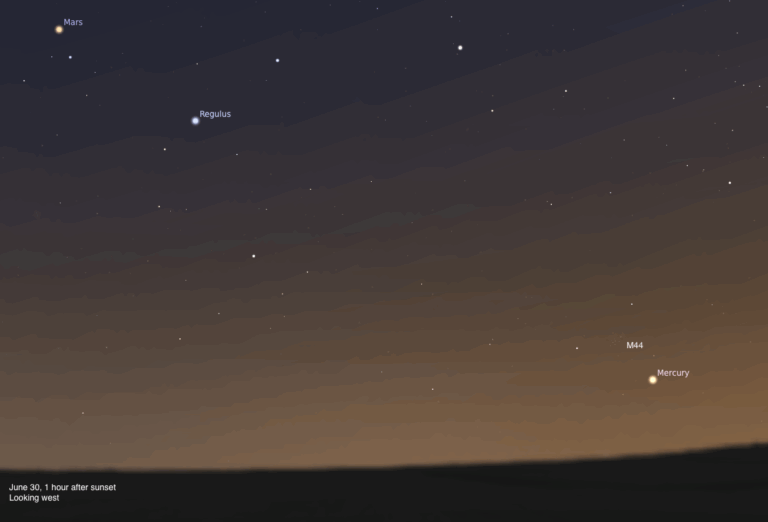
Jupiter is the highlight of evening observation for anyone with a telescope. Its moons dance around the planet and intriguing transits and occultations occur. Meanwhile, Saturn is very low in twilight — you can catch it early in the month. The binocular giants, Uranus and Neptune, are visible all evening. The morning sky carries a bright Venus and the return of Mars; the two undergo a close conjunction later in February. And spy Mercury early in the month before it goes behind the Sun.
Catch Saturn 45 minutes after sunset on Feb. 1, when it stands 12° high in the west. The planet is lost in twilight after the second week of the month. Your last view may be Feb. 10, when a 1.1-day-old Moon stands just over 2° south of Saturn. The pair is 6° high 30 minutes after sunset and drops below the horizon about half an hour later. Saturn shines at magnitude 0.9 and can be spotted easily with binoculars.
Saturn reaches superior conjunction Feb. 28 and will reappear in the morning sky in late March.
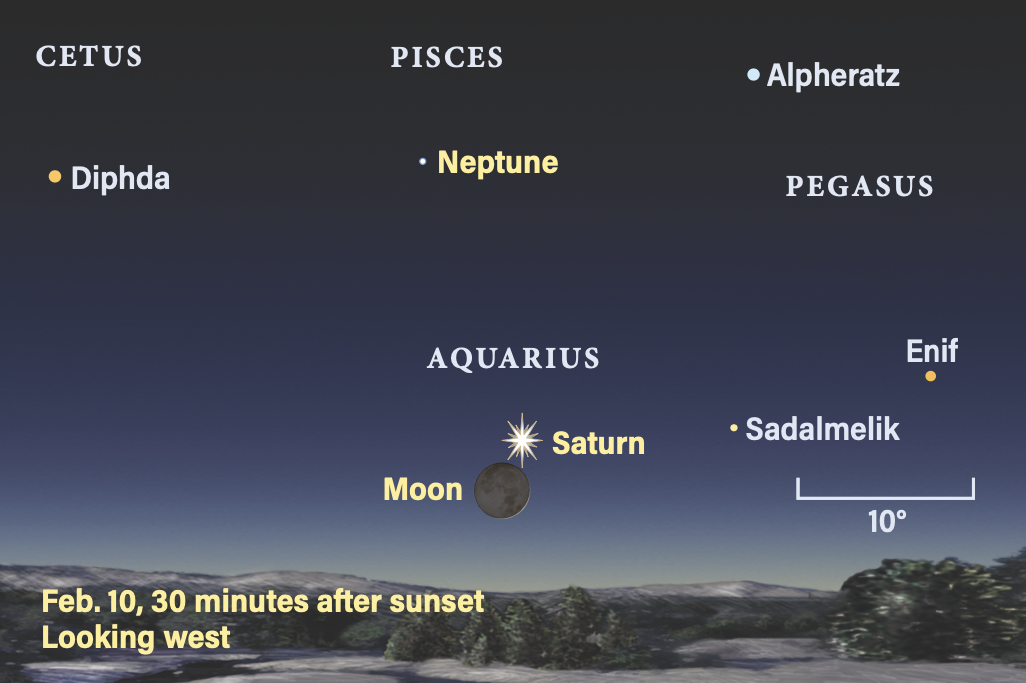
Neptune sets around 8:30 p.m. local time in the first week of February, so it’s best viewed before 7:30 p.m., when it drops below 10° altitude. It’s located in Pisces the Fish, just south of the Circlet asterism. Neptune shines at magnitude 7.8.
A line of three 5th- to 6th-magnitude stars spans nearly 3°, running southeast to northwest due east of Neptune’s location and some 5° south-southeast of magnitude 4.5 Lambda (λ) Piscium. Binoculars will easily find the trio, with Neptune standing 40′ west of the northwesternmost star, 20 Psc. There’s a 7th-magnitude star just slightly brighter than the planet in the same field of view, southwest of Neptune. The gap between Neptune and 20 Psc narrows to 15′ by Feb. 15 as the giant planet moves east.
That easterly trek continues but Neptune is setting earlier each night, becoming more difficult to follow at low altitude. Neptune passes 8′ due north of 20 Psc on the 23rd, but the two are only 8° high in the western sky an hour after sunset, and set by 7:30 p.m. local time.
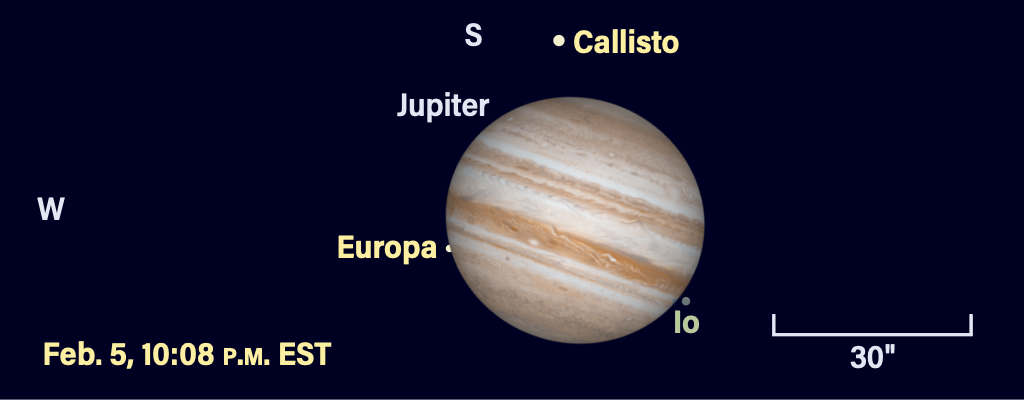
Jupiter is a stunning object high in the southern sky as February opens. It’s located in Aries the Ram and shines at magnitude –2.3 on Feb. 1, dimming to magnitude –2.2 by the 29th. Begin your observing as twilight falls — the lower contrast of the jovian disk is a sight to behold. You’ll easily catch the four bright Galilean moons in any telescope, and even through binoculars.
As the night proceeds, Jupiter’s altitude drops. On Feb. 1 it stands 60° high at 7 p.m. local time; three hours later it is half that. Jupiter sets by 12:30 a.m. local time on Feb. 1 and nearly two hours earlier by the 29th. The apparent diameter of planet’s disk shrinks from 39″ to 36″ during the same period. That disk offers prominent weather systems that change hourly, including the dark North and South equatorial belts that straddle the equator. Be on the lookout for the Great Red Spot, which is carried around the planet once every 10 hours and makes an appearance every other day or so.
The Galilean moons — Io, Europa, Ganymede, and Callisto — undergo transits and occultations. What follows is not an exhaustive list but focuses on some highlights.
The combination of one moon’s disappearance with another’s reappearance occurs Feb. 5. Look before 10 p.m. EST and you’ll see Europa approaching the western limb. But watch the eastern limb at the same latitude and at about 10:05 p.m. EST, Io reappears from behind Jupiter — though the small moon is traveling through the planet’s long shadow. Within four minutes, Europa disappears behind Jupiter’s disk. Io finally emerges into the sunlight just after 11:20 p.m. EST. During the event, Callisto stands southwest of Jupiter and Ganymede lies far to the west.
Ganymede, Jupiter’s largest moon, reappears from behind the planet’s northeastern limb soon after 10:40 p.m. CST on Feb. 7. (Note the planet is very low in the Eastern time zone and difficult to observe.) It takes a few minutes to fully emerge. When do you first notice it?
Feb. 13 finds Io and its shadow tracing a path across the face of Jupiter. Io’s trek is best seen from the eastern half of the U.S. this time, as the moon exits the disk around 9:19 p.m. EST, just as full darkness arrives in the Mountain time zone. The shadow exits shortly before 9:40 p.m. CST, again as the planet is very low for East Coast observers.
Europa follows suit the next evening, Feb. 14, when the moon ends its transit around 9:43 p.m. EST. Within 15 minutes, its shadow appears on the opposite (eastern) limb and leaves around 11:11 p.m. CST.
Ganymede’s shadow is always a treat to observe as it’s the largest shadow and, due to the tilt of the moon’s orbit relative to our line of sight, it crosses the extreme southern portion of Jupiter, displaying a very elongated shape. Such a shadow transit begins around 9:30 p.m. EST on Feb. 18. The shadow begins its long exit shortly after 10 p.m. CST. Observers can view Ganymede itself making a transit across the south polar region on Feb. 25 between about 8:30 p.m. and 10:30 p.m. EST.
Uranus, also in Aries, starts the month 12° farther east along the ecliptic than Jupiter. The distance between the planets shrinks to 8° by the end of the month. Uranus dims to magnitude 5.8 and is best seen through binoculars or a telescope. It’s located some 12° southwest of the Pleiades (M45), a short hop with binoculars. On the last day of February, you’ll find the dim bluish planet 37′ due south of 53 Arietis. The planet spends the whole month in this 6th-magnitude star’s vicinity, a region some 2° south and slightly west of Botein, the 4th-magnitude star also known as Delta (δ) Arietis.
You’ll find Uranus 3° south of a nearly First Quarter Moon Feb. 15. The planet stands almost 20 astronomical units (1.86 billion miles; 1 astronomical unit, or AU, is the average Earth-Sun distance) from Earth by the end of the month. Through a telescope, it shows off a tiny 4″-wide disk.
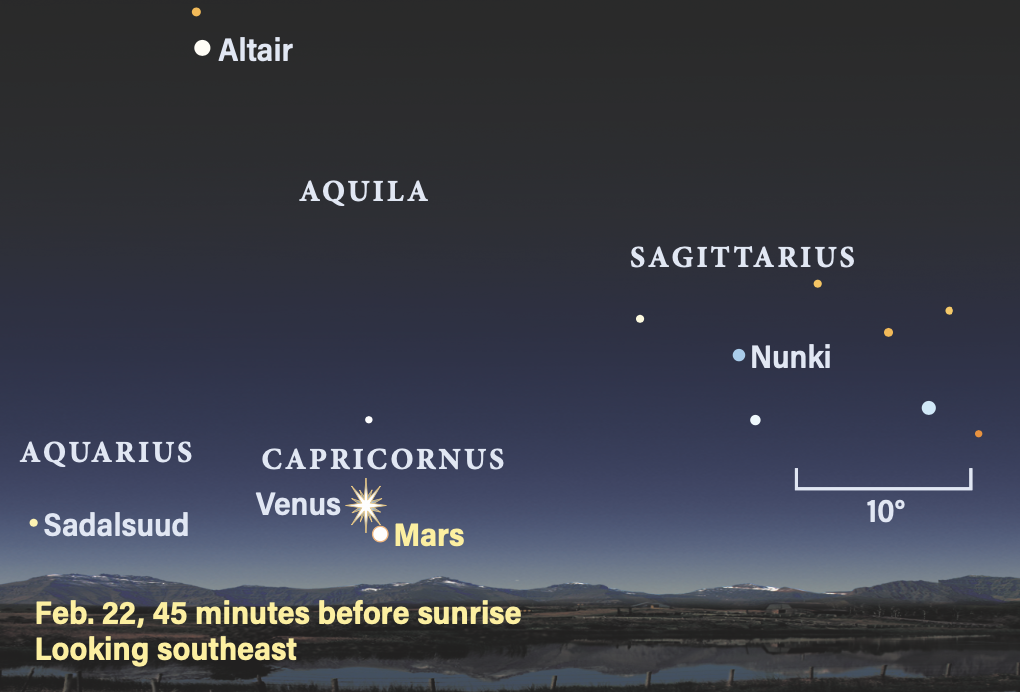
Early on Feb. 1, Mercury, Mars, and Venus are spread out over 13° along the ecliptic in morning twilight. Mercury and Mars stand 3.5° apart.
Mercury shines at magnitude –0.3 and stands only 3° high in the southeast 30 minutes before sunrise. Mars is more difficult at magnitude 1.3, but rises 10 minutes before Mercury. With a very clear eastern horizon and some luck, you might spot the Red Planet 10° to the lower left of Venus 45 minutes before sunrise.
Mercury is lost in the first few days of February as it heads for solar conjunction. As the month progresses, Venus drops in altitude while Mars gains it. They meet on Feb. 22, with Mars 36′ due south of Venus. The latter is an easy target at magnitude –3.9. The pair stands 3° high in the southeast 45 minutes before sunrise (about 6 a.m. local time for U.S. observers). If you can swing a telescope this low, you’ll find Venus spanning 11″ and revealing a 90-percent-lit disk, while Mars is about one-third that apparent size at 4″ wide, with close to a fully illuminated disk.
By the end of February, the planets stand more than 3° apart, with Venus getting lower and heading for solar conjunction, while Mars is on a long and slow increase in altitude. It will still be a few months before it becomes an easy object.
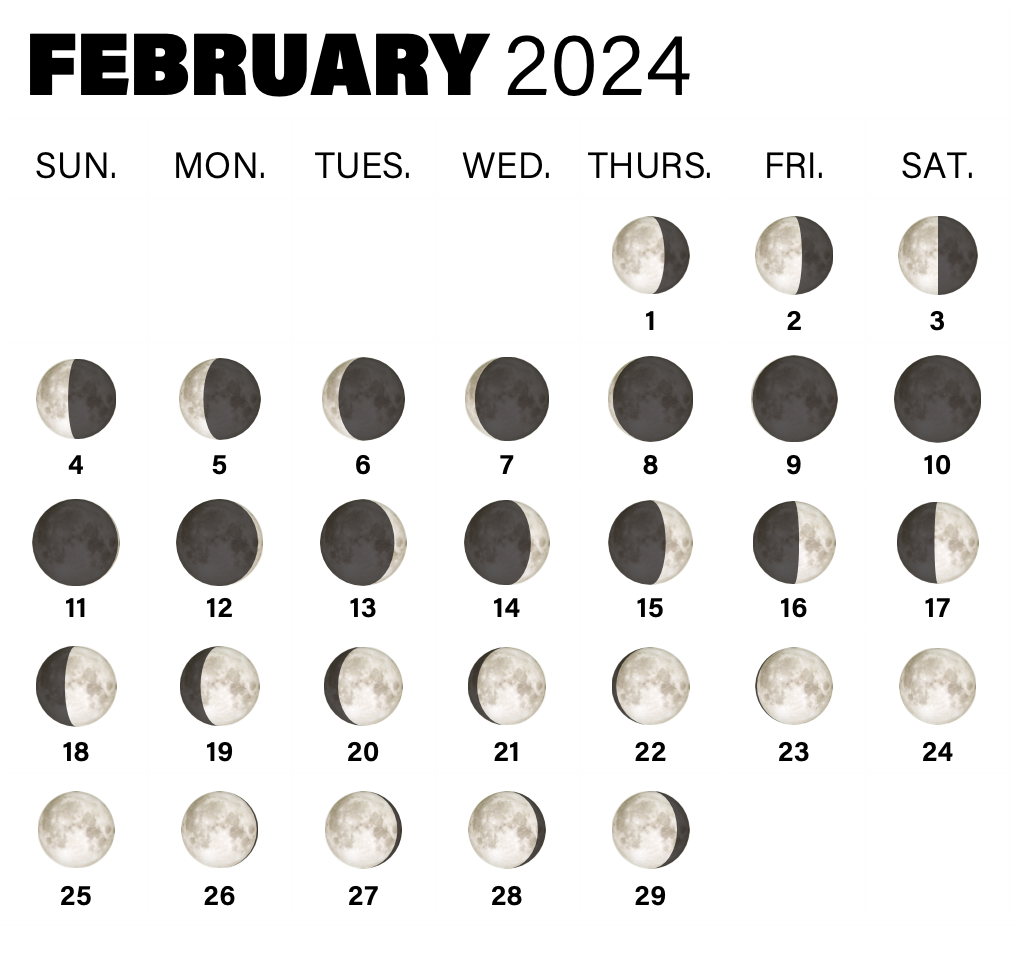
Rising Moon: Out of round
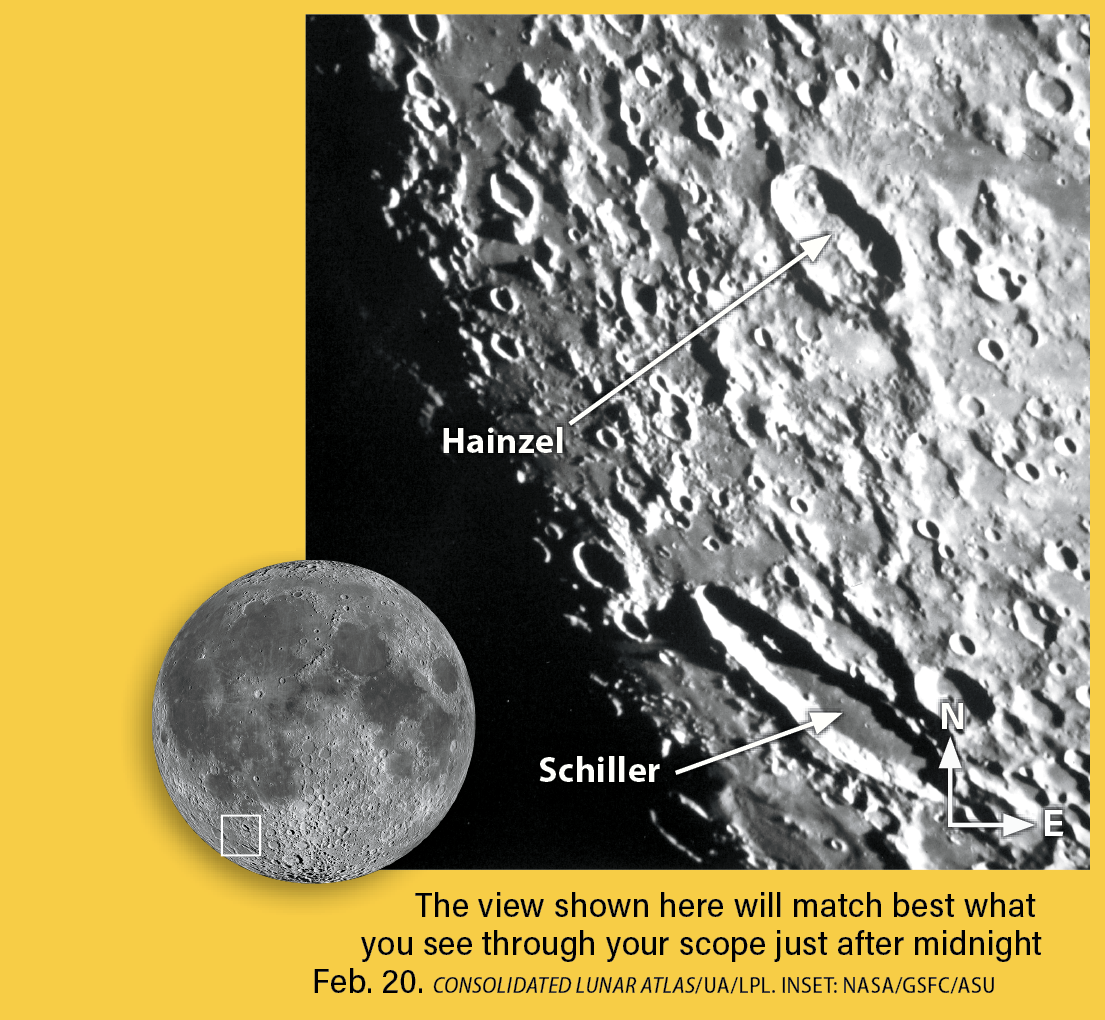
Standing out in the deep southwest of a waxing gibbous Moon lies the striking shoeprint form of Schiller. Only half of it is visible on the 19th, a few days before Full, sporting rim shadows reaching toothily into the darkness.
Lit up on Feb. 20th, Schiller’s mostly flat floor and overly elliptical shape catch the eye. Of course, all circular craters close to the Moon’s limb appear oval through foreshortening, but Schiller seems squashed twice as much as any other in the area. The following night, the shadows in Schiller are much shorter.
Earlier lunar observers were left scratching their heads trying to explain its form. Research into high-velocity impacts a few decades ago showed that a single projectile at a grazing angle could produce unusual craters, including ones like Schiller. Well after the initial impact, lava welled up through fractures in the crust to make a smooth floor. Messier A in the Moon’s southeast is the poster child for low-angle impacts.
To the northeast, you can’t miss the complex elliptical crater Hainzel. Look closely and you can figure out that this feature was created over time by separate impacts. On the northwest side is a roughly circular form with a classic central peak. The southeast region seems to have come later because the floor of the overlapping area
is a better match for texture and albedo. The southern component was first not only because the other two overlay it, but also because its rim is softer, a result of wear and tear from long-term bombardment.
When you’re done, take a close look at the staggeringly bright Aristarchus in the northern third of the Moon. When Earth’s atmosphere is very turbulent or the Moon is very low to the horizon, refraction effects can sometimes give the appearance of outgassing and colored vapors.
Meteor Watch: View the false dusk
Meteors are rare in February, with no major showers. The background rate of half a dozen or so meteors per hour is best seen in the evening sky for the first half of the month, when the Moon is out of the way. Earth’s orbital path crosses many ancient streams that have long since dispersed to create this sporadic background.
The plane of the ecliptic is also littered with fine meteoritic debris and in early February, the combined glow of this material reflecting sunlight can be seen as a faint cone of light above the western horizon once evening twilight has all but disappeared.
This is the zodiacal light and it is visible only from locations far from city glow. Getting to a high altitude helps as well, as this reduces the scattered light from our own atmosphere. Shimmering almost as bright as the Milky Way when viewed from very dark locations, the zodiacal light passes through the constellations Aquarius, Pisces, and Aries. See if your location is dark enough to spot it extending to near the Pleiades in Taurus.
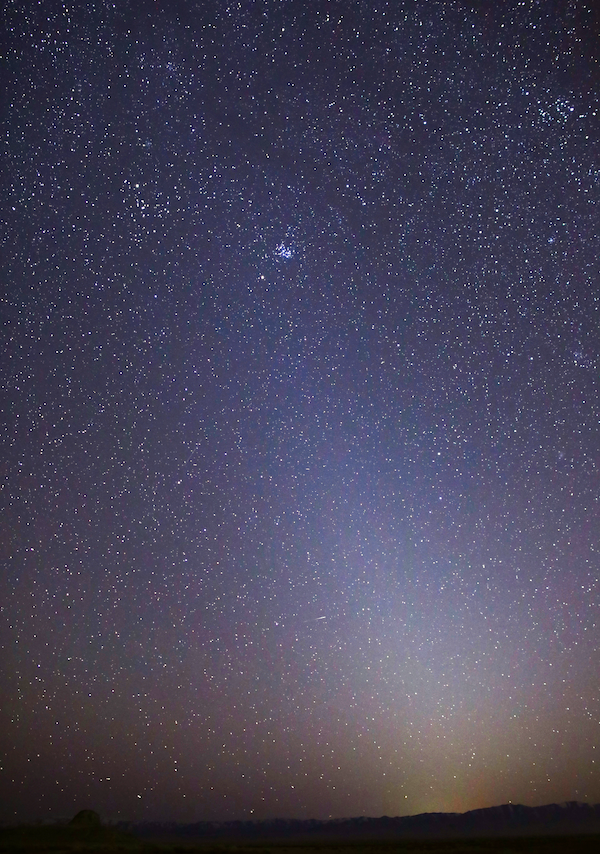
Comet Search: All night long!
The cornucopia opens at nightfall with 8th-magnitude 12P/Pons-Brooks. Bring a detailed finder chart to a dark site for this rarely visited zone north of Pegasus. Visually you won’t see the green glow that imagers are posting, but you can detect color in the Blue Snowball (NGC 7662) just to the north late in the month. Even if Pons-Brooks does not repeat its earlier outbursts, next month it brightens past 6th magnitude.
Comet 144P/Kushida might just be visible in an 8-inch scope when it passes through the Hyades during February’s first week, then hides in Aldebaran’s ruddy glare on the 9th. All other comets noted here should be easy in a 4-inch from well outside the city.
Outshining the galaxies of the Virgo Cluster, Comet 62P/Tsuchinshan flaunts its 8th-magnitude glow in the gap between M87 and smaller M49 just 2° farther south. Hugging 5th-magnitude Rho (ρ) Virginis, by midnight Tsuchinshan is more than 15° high in the east.
Brighter (only this month) at 7th magnitude, C/2021 S3 (PanSTARRS) bookends the night before dawn breaks, climbing away from Antares low in the southeast. Better views are from the Gulf States, with peak geometry south of the equator. On the morning of the 11th, you can readily compare PanSTARRS to the globular star clusters just to its northeast. Is it brighter than M9? Two days later they share the same field, a great photo op with contrasting green and white snowballs.
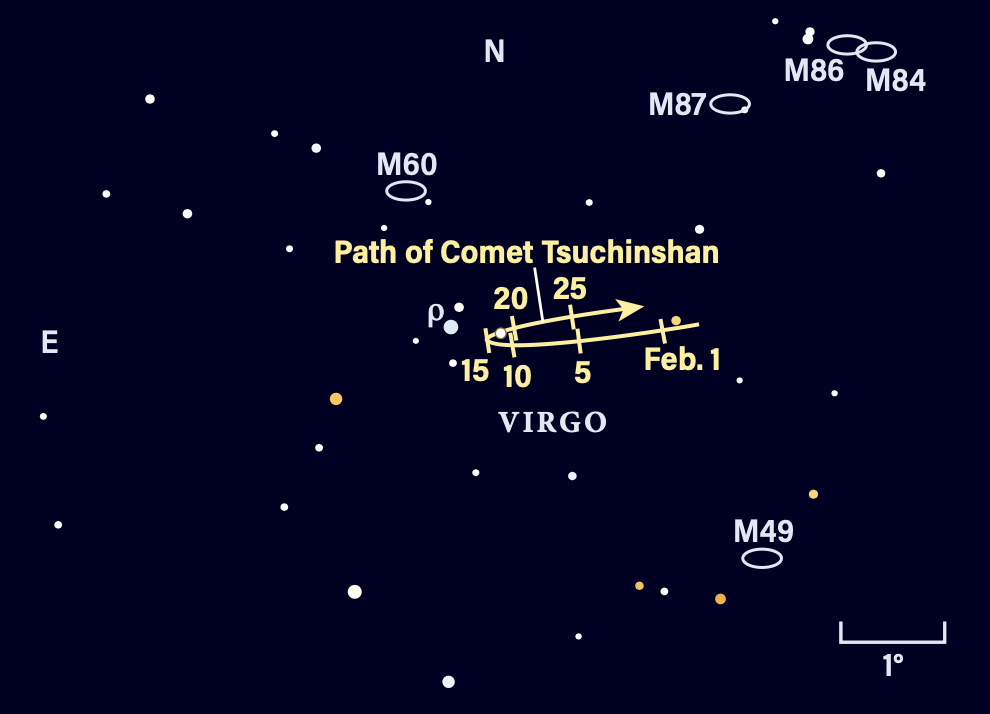
Locating Asteroids: Five-minute binocular watch
Even if you don’t have time — or it’s too cold — for a “proper” observing session, you can still snag an asteroid in the time it takes to play a typical song.
Binoculars or a grab-n-go mini-scope will readily reach 8th magnitude from most suburbs. Main-belt asteroid 4 Vesta fades through magnitude 7.5 this month, sitting one binocular field of view north of Zeta (ζ) Tauri, the star at the east end of the Bull’s southern horn. In a dark sky, you’ll pass by M1, the Crab Nebula. Thanks to all the dust in this part of the Milky Way, there is nothing to confuse you in this sparse backdrop. Avoid the 16th through the 19th, when the Moon is nearby, casting its glare all over.
Normally you can spot an asteroid shift against the background over the course of at least one evening each month, but not this time. Vesta is finishing its westward travel and backtracking to the east very slowly. This apparent retrograde loop is caused by the faster Earth overtaking Vesta on the inside track of our not-quite-circular orbits around the Sun. You might need four nights to notice a displacement.
Vesta spans some 300 miles, the second-largest object in the main belt. The Dawn spacecraft studied it closely back in 2011.
